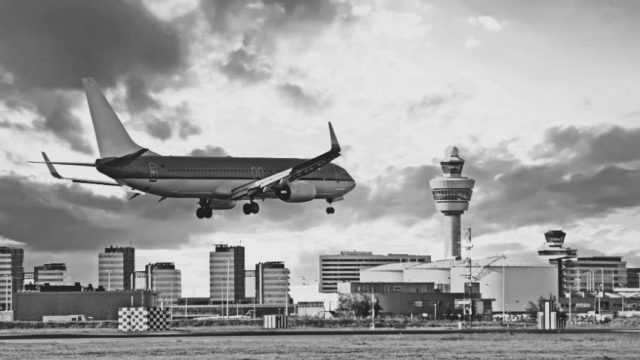…New white paper from the World Economic Forum explores the infrastructure changes and highlights 10 key findings for airlines and airports to meet the demand for alternative propulsion aircraft by 2050
…This research finds that shifting to alternative propulsion will require a capital investment of between $700 billion and $1.7 trillion across the value chain by 2050.
SAT, APRIL. 22 2023-theGBJournal |Hydrogen and electric aircraft could require 600-1,700 terawatt-hours (TWh) of clean energy by 2050, according to a new white paper from the World Economic Forum.
For context, the total amount of renewable energy produced in 2021 was just over 8,000 TWh globally.
To meet the estimated energy demand from hydrogen and electric aircraft in 2050 would require the amount of energy produced from 10-25 of the world’s largest wind farms, or a solar farm half the size of Belgium, the paper suggests.
Alternative, carbon-free propulsion options, such as battery and hydrogen-powered aircraft, are some of the options the aviation industry is pursuing to reach its net-zero carbon goals. By some estimates, hydrogen and electric planes could account for 21%-38% of flights by 2050.
“The aviation sector must make key investments in its infrastructure now if it wants to reach its net-zero target by 2050,” said David Hyde, Aerospace Projects Lead, World Economic Forum. “Given that the share of aviation’s global warming impact is set to rise significantly if action is not taken, the sector must consider all the options available for decarbonization. This includes preparing to use aircraft that are powered by carbon-free fuels at scale.”
While the timeline may feel distant, the first commercial flights by such aircraft are expected to take place this decade. Airports, airlines and others will need to make heavy infrastructure investment to deliver the green hydrogen and electricity the aircraft will need.
The white paper, Target True Zero: Delivering the infrastructure for battery- and hydrogen-powered flight, developed in collaboration with McKinsey, explores what these infrastructure changes entail and how airports and other stakeholders can begin to prepare for them.
In terms of investment, this research finds that shifting to alternative propulsion will require a capital investment of between $700 billion and $1.7 trillion across the value chain by 2050.
“Ground infrastructure will be an important unlock for battery-electric and hydrogen aircraft as they become available in the next decade as an additional option to make aviation sustainable,” said Robin Riedel, Partner and Co-Leader, McKinsey Center for Future Mobility. “It is important that stakeholders across the value chain, from governments to airports to electricity and hydrogen players to airlines begin planning and investing in it.”
Ten key findings
The report explores multiple areas where expanded infrastructure is needed to prepare for these new aircraft. It identifies 10 key findings for the aviation sector.
-Global demand for alternative propulsion could require 600-1,700 TWh of clean energy by 2050. This is equivalent to the energy generated by 10-25 of the world’s largest wind farms, or a solar farm half the size of Belgium.
-Large airports could consume 5-10 times more electricity by 2050 than they do today, to support alternative propulsion.
-Alternative propulsion will require two new infrastructure value chains – one for battery electric aviation and one for hydrogen – which may include a whole variety of new partners that are not currently part of the aviation ecosystem.
-Most airports have space for hydrogen liquefaction and storage infrastructure but not enough land to generate all of the clean energy needed to power battery-electric and hydrogen aircraft.
-Shifting to alternative propulsion will require capital investment of between $700 billion and $1.7 trillion across the value chain by 2050. Approximately 90% of this investment will be for off-airport infrastructure, primarily power generation and hydrogen electrolysis and liquefaction.
-Investment needed for airport infrastructure will be significantly higher for large airports than for smaller airports but of similar magnitude to other major investments, such as building a new terminal.
-Costs to operators of alternative propulsion are expected to be around 76-86% over the market price for green electricity – reflecting additional aviation infrastructure operating costs
-The investment needed to meet 2050 goals must start now. The first elements of on-airport infrastructure must be in place by 2025 to meet expected energy demand.
-To harness the power of network effects and regional connectivity, coordination of infrastructure investment will be required to make alternative propulsion operations feasible.
-The aviation industry will need to partner with other industries to secure enough green electricity and hydrogen in a supply-constrained environment and have a voice in shaping the future of the hydrogen ecosystem.
Investment requirements and pathways
Despite high price tags, the infrastructure investment needed is similar to what airports may spend on similar expansions or upgrades. Investment needed for airport infrastructure will be significantly higher for large airports than for smaller airports but of similar magnitude to other major investments, such as building a new terminal.
The costs for an international hub or major regional airport, for example, would be roughly equivalent to the LaGuardia Airport terminal expansion or about 20% of the cost of London Heathrow’s third runway project. The costs for smaller airports will be much lower as these will not have to support larger aircraft that require more advanced infrastructure.
Given that about 90% of this investment will be for off-airport infrastructure, primarily power generation and hydrogen electrolysis and liquefaction, the aviation sector will need to partner with other industries to support their infrastructure needs. This could include partnering with energy suppliers for green hydrogen and electricity production or partnering with equipment manufacturers for energy storage needs.
Airports can already begin to map the local ecosystem of hydrogen and energy projects to identify specific stakeholders to partner with. To this end, the World Economic Forum is launching the Airports of Tomorrow initiative, convening executives from the airport ecosystem to proactively address their energy, infrastructure and financing needs in the coming decades.
Twitter-@theGBJournal|Facebook-the Government and Business Journal|email:gbj@govbusinessjournal.ng| govandbusinessj@gmail.com










